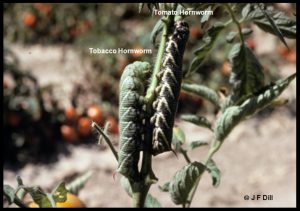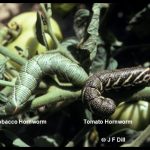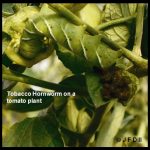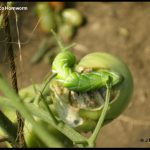Hornworms
 Hornworms are the caterpillars of a family of moths called sphinx moths or hawk moths (Sphingidae). The caterpillars are so-named for the prominent horny spike that protrudes up from the end of the abdomen, and the hornworm caterpillar most likely to be seen in the home garden in Maine is the tobacco hornworm, Manduca sexta. It feeds on the leaves and stems of primarily tomato in our part of the country but there are additional plants from the Solanaceae family that it will eat as well, such as eggplant, pepper, potato, and, of course, in the southern US, tobacco, for which it is named and for which it is very economically significant. It is pale green in color (sometimes brown), and is a master of camouflage, allowing it to go largely unnoticed by human eyes until it is full size or close to full size (roughly three to four inches long).
Hornworms are the caterpillars of a family of moths called sphinx moths or hawk moths (Sphingidae). The caterpillars are so-named for the prominent horny spike that protrudes up from the end of the abdomen, and the hornworm caterpillar most likely to be seen in the home garden in Maine is the tobacco hornworm, Manduca sexta. It feeds on the leaves and stems of primarily tomato in our part of the country but there are additional plants from the Solanaceae family that it will eat as well, such as eggplant, pepper, potato, and, of course, in the southern US, tobacco, for which it is named and for which it is very economically significant. It is pale green in color (sometimes brown), and is a master of camouflage, allowing it to go largely unnoticed by human eyes until it is full size or close to full size (roughly three to four inches long).
Another hornworm that is similar enough to the tobacco hornworm to cause a lot of people to confuse the two–and which shares many of the same host plants–is the tomato hornworm, Manduca quinquemaculata (pictured above beside a tobacco hornworm). However, though both species feed frequently on tomato, the tomato hornworm is encountered by Maine homeowners far less often than is the tobacco hornworm, which can be readily identified by seven straight, white lines on its body and a red horn compared to “V“-shaped white markings and a black horn found on the tomato hornworm.
- Tobacco Hornworm (left) and a Tomato Hornworm (right); many people in Maine and beyond encounter tobacco hornworms feasting on their tomato plants so incorrectly assume they are tomato hornworms.
- Tobacco Hornworm (Manduca sexta) (St. George, ME; 8/12/2024) (Photo courtesy of B. Mroz)
- Tobacco Hornworm (Manduca sexta) (St. George, ME; 8/14/2025) (Photo courtesy of B. Mroz)
- Tobacco Hornworm; one can differentiate it from a tomato hornworm by virtue of its seven straight white lines on its side
- Tobacco Hornworm feeding on a tomato (seven white lines on each side of its body)
- Collection of Hornworm Photos, including the Laurel Sphinx (USGS)
- Tobacco Hornworm pupae (Manduca sexta) (Etna, ME; 8/26/2025)
Additional Information:
- Tobacco Hornworm: Hungry Caterpillars in the Garden (Penn State Extension)
- Great example of color variation between two tobacco hornworm specimens (BugGuide.net)
- Tomato Hornworms in Home Gardens (University of Minnesota)
- Hornworms (tobacco and tomato) (Kansas State University)
- Tobacco Hornworm adult: Carolina sphinx moth (Butterflies and Moths of North America Project)
- Tomato Hornworm adult: Five-spotted hawkmoth (Butterflies and Moths of North America Project)
- Laurel Sphinx Hornworm (USGS)







